Article Analysis: Customer & Supplier Collaboration in Business Firms
VerifiedAdded on 2023/06/15
|9
|2296
|290
Essay
AI Summary
This essay presents an in-depth analysis of two articles. The first article examines the impact of customer and supplier collaborations on professional service firms (PSFs) in competitive, turbulent environments, arguing that such collaborations can have negative effects due to self-interest, lack of trust, and short-term orientations. The analysis highlights that in rapidly changing markets, firms may prioritize immediate gains over long-term collaborative relationships, leading to ineffective information sharing and compromised customer service. The second article focuses on the segmentation of the airline market in the Gulf Cooperation Council (GCC) region, profiling business customers based on their preference for low-cost carriers (LCCs) versus full-service carriers (FSCs). It suggests that LCCs are increasingly favored due to their cost-effectiveness and expanded service offerings, challenging the traditional dominance of FSCs, especially among younger professionals and smaller companies seeking value without sacrificing essential service quality. Both analyses underscore the importance of adapting business strategies to dynamic market conditions and evolving customer needs.
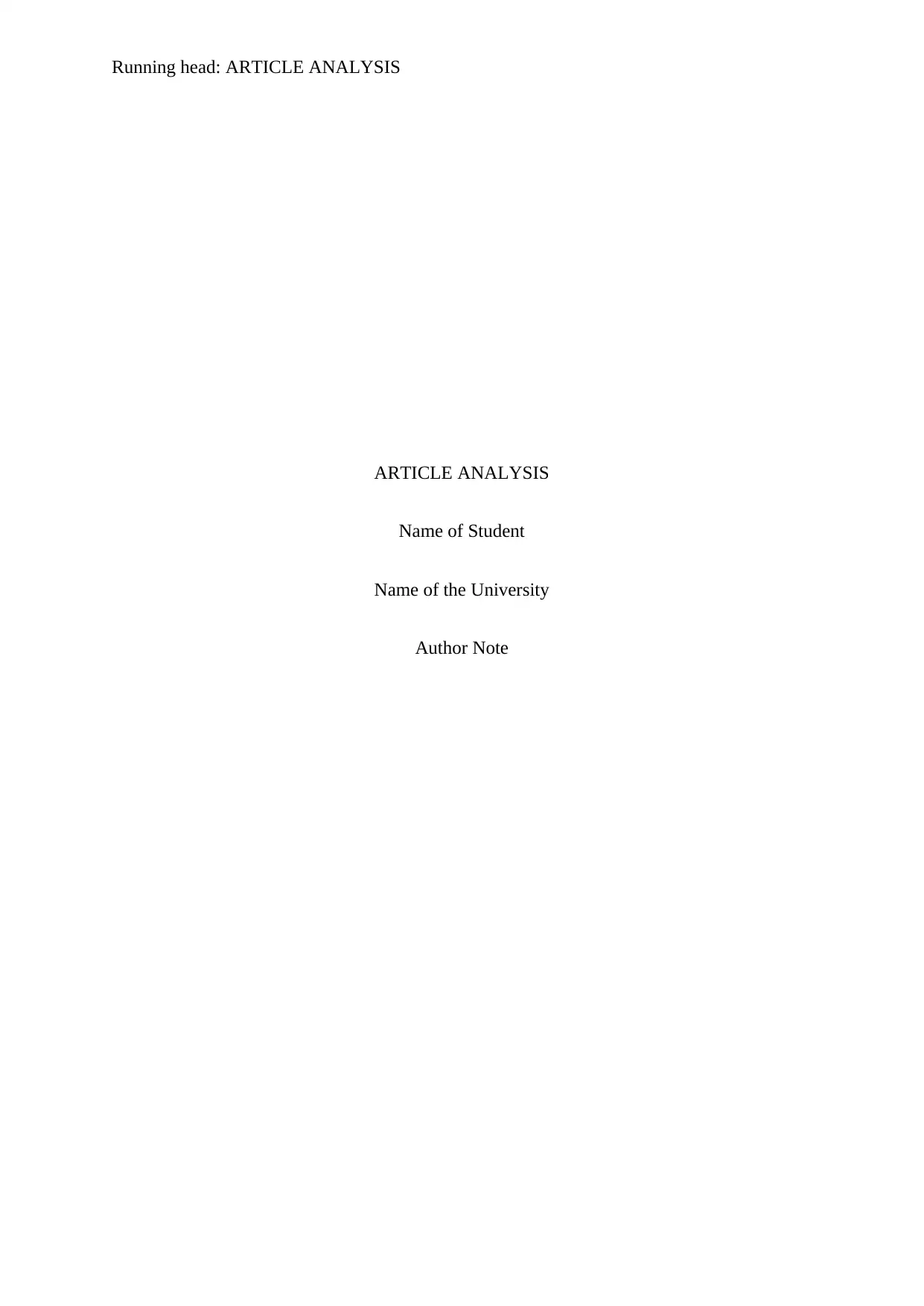
Running head: ARTICLE ANALYSIS
ARTICLE ANALYSIS
Name of Student
Name of the University
Author Note
ARTICLE ANALYSIS
Name of Student
Name of the University
Author Note
Paraphrase This Document
Need a fresh take? Get an instant paraphrase of this document with our AI Paraphraser

1ARTICLE ANALYSIS
Article 1
Title of the Article: Do Professional Service Firms Benefit from Customer and Supplier
Collaborations in Competitive, Turbulent Environments?
Authors of the Article: Nima Heirati, Aron O’Cass, Klaus Schoefer, Vida Siahtiri
Introduction
Most of the recent business studies conducted focus on the good part played by
effective collaboration of the firms with customers and the suppliers. However, it must be
noted that collaboration of the firms with customers and the suppliers can have both good as
well as bad effects especially in an industrial environment that constantly seeks to gain
competitive advantage (Wang et al., 2015). The thesis statement of the essay is in support of
the article reviewed that in the face of a highly competitive and challenging business
environment, the collaboration of the firms with customers and suppliers can pose negative
effects on the firms especially in the sectors of customer service.
Discussion
In the context of customer service in a hostile business environment that is constantly
changing, customer and supplier collaboration of firms can be targeted towards self-interests.
Such a view can be backed up by the fact that collaboration between the suppliers and the
customers can create a flow of exchange in knowledge in minimum cost. However, the highly
hostile condition of the industry where each organization tries to gain competitive advantage
over the others, makes the firms to be overly concerned in sharing information that is
valuable with the suppliers that causes for the ineffectiveness in the firm-supplier
collaboration (Narayanan, Narasimhan & Schoenherr, 2015). This is because, withholding
critical information from the suppliers may make the suppliers hesitant in sharing information
Article 1
Title of the Article: Do Professional Service Firms Benefit from Customer and Supplier
Collaborations in Competitive, Turbulent Environments?
Authors of the Article: Nima Heirati, Aron O’Cass, Klaus Schoefer, Vida Siahtiri
Introduction
Most of the recent business studies conducted focus on the good part played by
effective collaboration of the firms with customers and the suppliers. However, it must be
noted that collaboration of the firms with customers and the suppliers can have both good as
well as bad effects especially in an industrial environment that constantly seeks to gain
competitive advantage (Wang et al., 2015). The thesis statement of the essay is in support of
the article reviewed that in the face of a highly competitive and challenging business
environment, the collaboration of the firms with customers and suppliers can pose negative
effects on the firms especially in the sectors of customer service.
Discussion
In the context of customer service in a hostile business environment that is constantly
changing, customer and supplier collaboration of firms can be targeted towards self-interests.
Such a view can be backed up by the fact that collaboration between the suppliers and the
customers can create a flow of exchange in knowledge in minimum cost. However, the highly
hostile condition of the industry where each organization tries to gain competitive advantage
over the others, makes the firms to be overly concerned in sharing information that is
valuable with the suppliers that causes for the ineffectiveness in the firm-supplier
collaboration (Narayanan, Narasimhan & Schoenherr, 2015). This is because, withholding
critical information from the suppliers may make the suppliers hesitant in sharing information
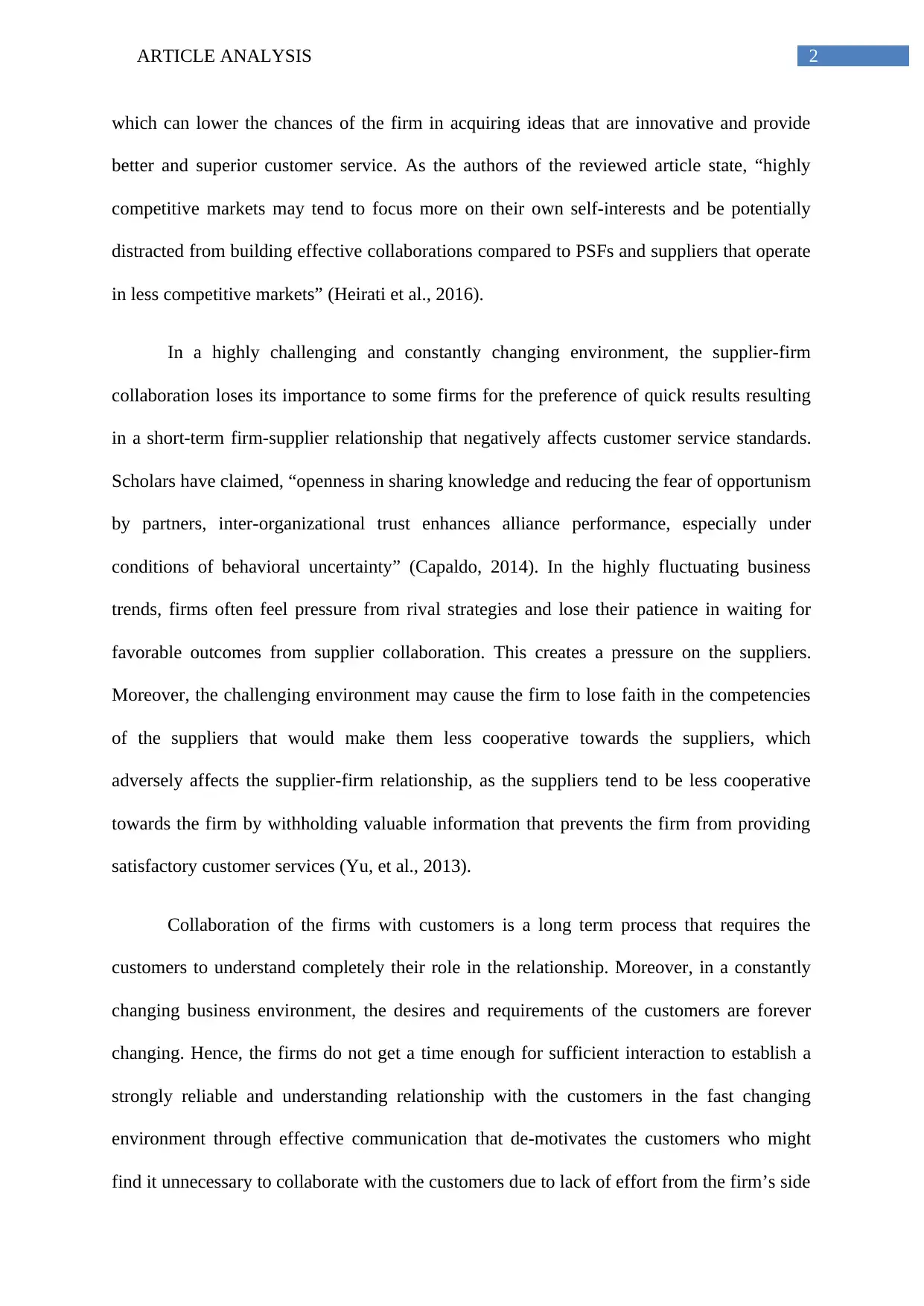
2ARTICLE ANALYSIS
which can lower the chances of the firm in acquiring ideas that are innovative and provide
better and superior customer service. As the authors of the reviewed article state, “highly
competitive markets may tend to focus more on their own self-interests and be potentially
distracted from building effective collaborations compared to PSFs and suppliers that operate
in less competitive markets” (Heirati et al., 2016).
In a highly challenging and constantly changing environment, the supplier-firm
collaboration loses its importance to some firms for the preference of quick results resulting
in a short-term firm-supplier relationship that negatively affects customer service standards.
Scholars have claimed, “openness in sharing knowledge and reducing the fear of opportunism
by partners, inter-organizational trust enhances alliance performance, especially under
conditions of behavioral uncertainty” (Capaldo, 2014). In the highly fluctuating business
trends, firms often feel pressure from rival strategies and lose their patience in waiting for
favorable outcomes from supplier collaboration. This creates a pressure on the suppliers.
Moreover, the challenging environment may cause the firm to lose faith in the competencies
of the suppliers that would make them less cooperative towards the suppliers, which
adversely affects the supplier-firm relationship, as the suppliers tend to be less cooperative
towards the firm by withholding valuable information that prevents the firm from providing
satisfactory customer services (Yu, et al., 2013).
Collaboration of the firms with customers is a long term process that requires the
customers to understand completely their role in the relationship. Moreover, in a constantly
changing business environment, the desires and requirements of the customers are forever
changing. Hence, the firms do not get a time enough for sufficient interaction to establish a
strongly reliable and understanding relationship with the customers in the fast changing
environment through effective communication that de-motivates the customers who might
find it unnecessary to collaborate with the customers due to lack of effort from the firm’s side
which can lower the chances of the firm in acquiring ideas that are innovative and provide
better and superior customer service. As the authors of the reviewed article state, “highly
competitive markets may tend to focus more on their own self-interests and be potentially
distracted from building effective collaborations compared to PSFs and suppliers that operate
in less competitive markets” (Heirati et al., 2016).
In a highly challenging and constantly changing environment, the supplier-firm
collaboration loses its importance to some firms for the preference of quick results resulting
in a short-term firm-supplier relationship that negatively affects customer service standards.
Scholars have claimed, “openness in sharing knowledge and reducing the fear of opportunism
by partners, inter-organizational trust enhances alliance performance, especially under
conditions of behavioral uncertainty” (Capaldo, 2014). In the highly fluctuating business
trends, firms often feel pressure from rival strategies and lose their patience in waiting for
favorable outcomes from supplier collaboration. This creates a pressure on the suppliers.
Moreover, the challenging environment may cause the firm to lose faith in the competencies
of the suppliers that would make them less cooperative towards the suppliers, which
adversely affects the supplier-firm relationship, as the suppliers tend to be less cooperative
towards the firm by withholding valuable information that prevents the firm from providing
satisfactory customer services (Yu, et al., 2013).
Collaboration of the firms with customers is a long term process that requires the
customers to understand completely their role in the relationship. Moreover, in a constantly
changing business environment, the desires and requirements of the customers are forever
changing. Hence, the firms do not get a time enough for sufficient interaction to establish a
strongly reliable and understanding relationship with the customers in the fast changing
environment through effective communication that de-motivates the customers who might
find it unnecessary to collaborate with the customers due to lack of effort from the firm’s side
⊘ This is a preview!⊘
Do you want full access?
Subscribe today to unlock all pages.

Trusted by 1+ million students worldwide
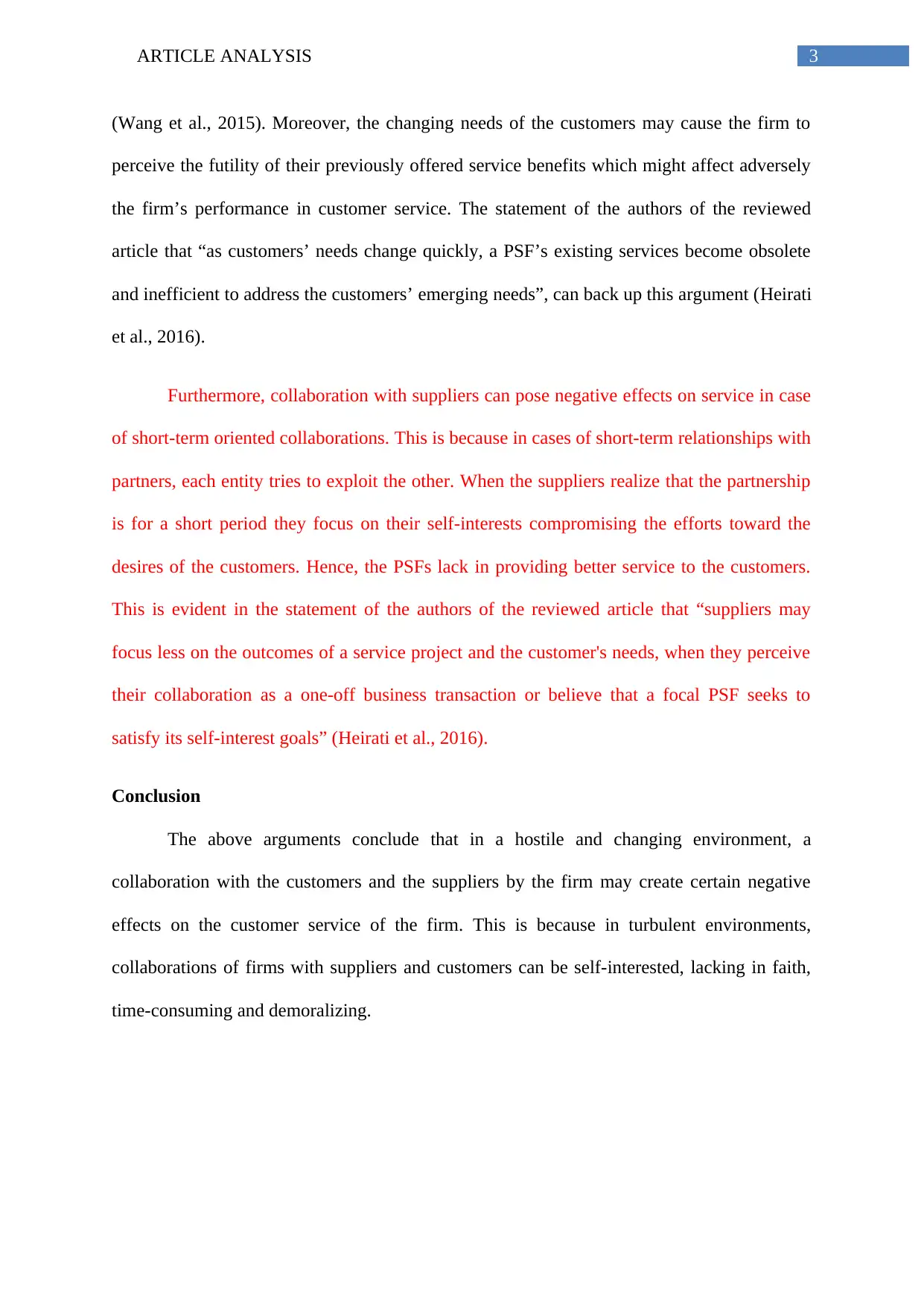
3ARTICLE ANALYSIS
(Wang et al., 2015). Moreover, the changing needs of the customers may cause the firm to
perceive the futility of their previously offered service benefits which might affect adversely
the firm’s performance in customer service. The statement of the authors of the reviewed
article that “as customers’ needs change quickly, a PSF’s existing services become obsolete
and inefficient to address the customers’ emerging needs”, can back up this argument (Heirati
et al., 2016).
Furthermore, collaboration with suppliers can pose negative effects on service in case
of short-term oriented collaborations. This is because in cases of short-term relationships with
partners, each entity tries to exploit the other. When the suppliers realize that the partnership
is for a short period they focus on their self-interests compromising the efforts toward the
desires of the customers. Hence, the PSFs lack in providing better service to the customers.
This is evident in the statement of the authors of the reviewed article that “suppliers may
focus less on the outcomes of a service project and the customer's needs, when they perceive
their collaboration as a one-off business transaction or believe that a focal PSF seeks to
satisfy its self-interest goals” (Heirati et al., 2016).
Conclusion
The above arguments conclude that in a hostile and changing environment, a
collaboration with the customers and the suppliers by the firm may create certain negative
effects on the customer service of the firm. This is because in turbulent environments,
collaborations of firms with suppliers and customers can be self-interested, lacking in faith,
time-consuming and demoralizing.
(Wang et al., 2015). Moreover, the changing needs of the customers may cause the firm to
perceive the futility of their previously offered service benefits which might affect adversely
the firm’s performance in customer service. The statement of the authors of the reviewed
article that “as customers’ needs change quickly, a PSF’s existing services become obsolete
and inefficient to address the customers’ emerging needs”, can back up this argument (Heirati
et al., 2016).
Furthermore, collaboration with suppliers can pose negative effects on service in case
of short-term oriented collaborations. This is because in cases of short-term relationships with
partners, each entity tries to exploit the other. When the suppliers realize that the partnership
is for a short period they focus on their self-interests compromising the efforts toward the
desires of the customers. Hence, the PSFs lack in providing better service to the customers.
This is evident in the statement of the authors of the reviewed article that “suppliers may
focus less on the outcomes of a service project and the customer's needs, when they perceive
their collaboration as a one-off business transaction or believe that a focal PSF seeks to
satisfy its self-interest goals” (Heirati et al., 2016).
Conclusion
The above arguments conclude that in a hostile and changing environment, a
collaboration with the customers and the suppliers by the firm may create certain negative
effects on the customer service of the firm. This is because in turbulent environments,
collaborations of firms with suppliers and customers can be self-interested, lacking in faith,
time-consuming and demoralizing.
Paraphrase This Document
Need a fresh take? Get an instant paraphrase of this document with our AI Paraphraser
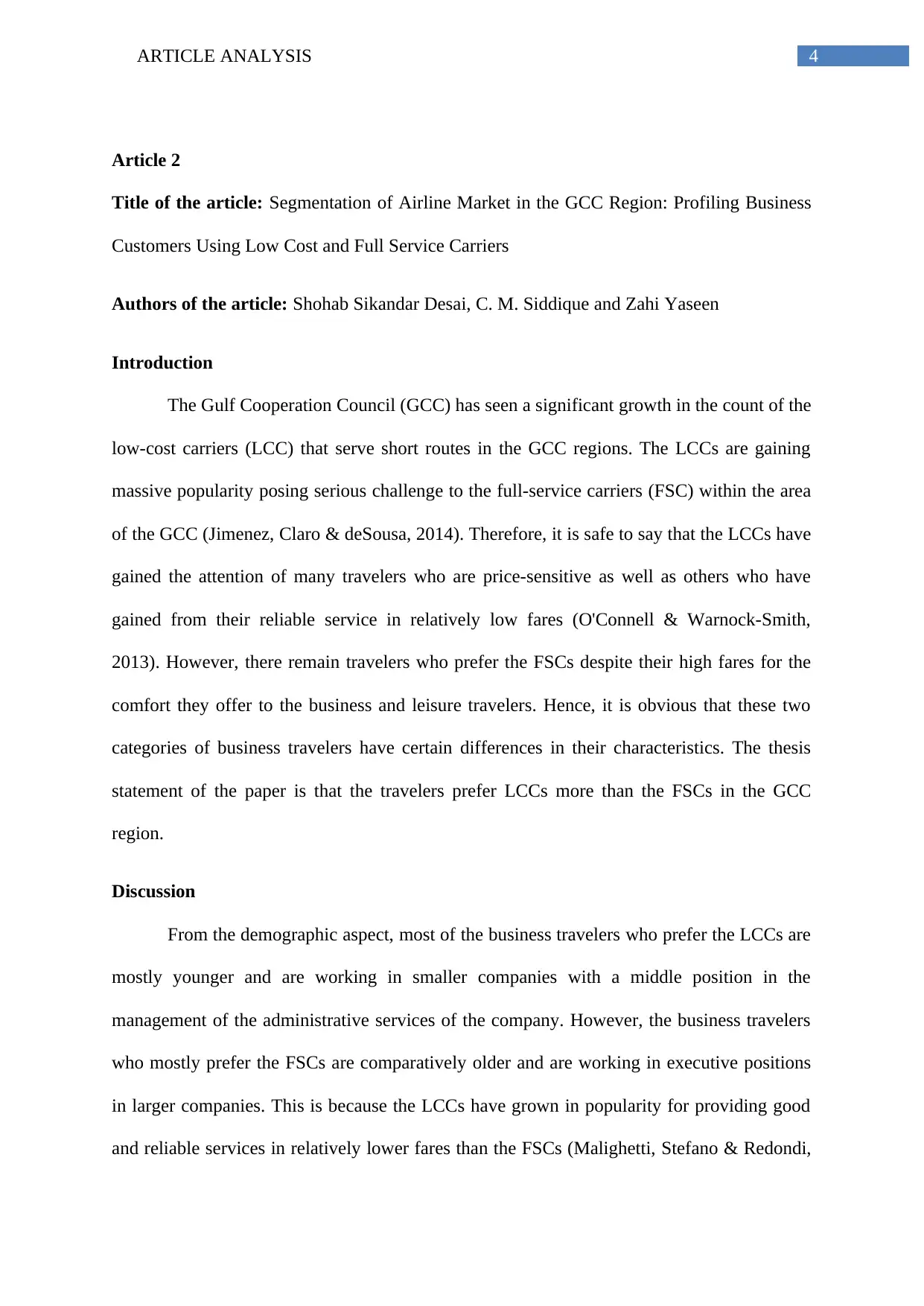
4ARTICLE ANALYSIS
Article 2
Title of the article: Segmentation of Airline Market in the GCC Region: Profiling Business
Customers Using Low Cost and Full Service Carriers
Authors of the article: Shohab Sikandar Desai, C. M. Siddique and Zahi Yaseen
Introduction
The Gulf Cooperation Council (GCC) has seen a significant growth in the count of the
low-cost carriers (LCC) that serve short routes in the GCC regions. The LCCs are gaining
massive popularity posing serious challenge to the full-service carriers (FSC) within the area
of the GCC (Jimenez, Claro & deSousa, 2014). Therefore, it is safe to say that the LCCs have
gained the attention of many travelers who are price-sensitive as well as others who have
gained from their reliable service in relatively low fares (O'Connell & Warnock-Smith,
2013). However, there remain travelers who prefer the FSCs despite their high fares for the
comfort they offer to the business and leisure travelers. Hence, it is obvious that these two
categories of business travelers have certain differences in their characteristics. The thesis
statement of the paper is that the travelers prefer LCCs more than the FSCs in the GCC
region.
Discussion
From the demographic aspect, most of the business travelers who prefer the LCCs are
mostly younger and are working in smaller companies with a middle position in the
management of the administrative services of the company. However, the business travelers
who mostly prefer the FSCs are comparatively older and are working in executive positions
in larger companies. This is because the LCCs have grown in popularity for providing good
and reliable services in relatively lower fares than the FSCs (Malighetti, Stefano & Redondi,
Article 2
Title of the article: Segmentation of Airline Market in the GCC Region: Profiling Business
Customers Using Low Cost and Full Service Carriers
Authors of the article: Shohab Sikandar Desai, C. M. Siddique and Zahi Yaseen
Introduction
The Gulf Cooperation Council (GCC) has seen a significant growth in the count of the
low-cost carriers (LCC) that serve short routes in the GCC regions. The LCCs are gaining
massive popularity posing serious challenge to the full-service carriers (FSC) within the area
of the GCC (Jimenez, Claro & deSousa, 2014). Therefore, it is safe to say that the LCCs have
gained the attention of many travelers who are price-sensitive as well as others who have
gained from their reliable service in relatively low fares (O'Connell & Warnock-Smith,
2013). However, there remain travelers who prefer the FSCs despite their high fares for the
comfort they offer to the business and leisure travelers. Hence, it is obvious that these two
categories of business travelers have certain differences in their characteristics. The thesis
statement of the paper is that the travelers prefer LCCs more than the FSCs in the GCC
region.
Discussion
From the demographic aspect, most of the business travelers who prefer the LCCs are
mostly younger and are working in smaller companies with a middle position in the
management of the administrative services of the company. However, the business travelers
who mostly prefer the FSCs are comparatively older and are working in executive positions
in larger companies. This is because the LCCs have grown in popularity for providing good
and reliable services in relatively lower fares than the FSCs (Malighetti, Stefano & Redondi,
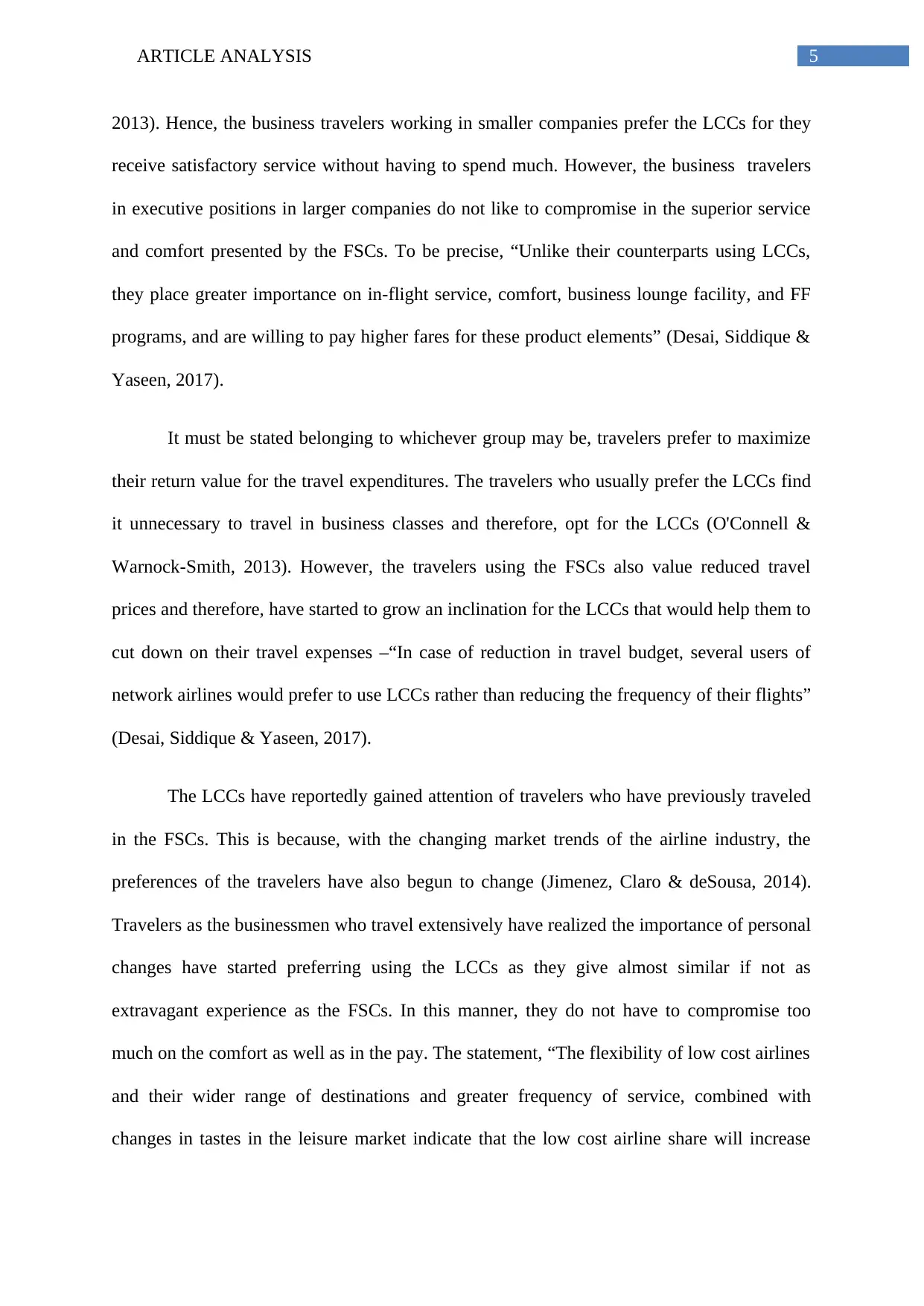
5ARTICLE ANALYSIS
2013). Hence, the business travelers working in smaller companies prefer the LCCs for they
receive satisfactory service without having to spend much. However, the business travelers
in executive positions in larger companies do not like to compromise in the superior service
and comfort presented by the FSCs. To be precise, “Unlike their counterparts using LCCs,
they place greater importance on in-flight service, comfort, business lounge facility, and FF
programs, and are willing to pay higher fares for these product elements” (Desai, Siddique &
Yaseen, 2017).
It must be stated belonging to whichever group may be, travelers prefer to maximize
their return value for the travel expenditures. The travelers who usually prefer the LCCs find
it unnecessary to travel in business classes and therefore, opt for the LCCs (O'Connell &
Warnock-Smith, 2013). However, the travelers using the FSCs also value reduced travel
prices and therefore, have started to grow an inclination for the LCCs that would help them to
cut down on their travel expenses –“In case of reduction in travel budget, several users of
network airlines would prefer to use LCCs rather than reducing the frequency of their flights”
(Desai, Siddique & Yaseen, 2017).
The LCCs have reportedly gained attention of travelers who have previously traveled
in the FSCs. This is because, with the changing market trends of the airline industry, the
preferences of the travelers have also begun to change (Jimenez, Claro & deSousa, 2014).
Travelers as the businessmen who travel extensively have realized the importance of personal
changes have started preferring using the LCCs as they give almost similar if not as
extravagant experience as the FSCs. In this manner, they do not have to compromise too
much on the comfort as well as in the pay. The statement, “The flexibility of low cost airlines
and their wider range of destinations and greater frequency of service, combined with
changes in tastes in the leisure market indicate that the low cost airline share will increase
2013). Hence, the business travelers working in smaller companies prefer the LCCs for they
receive satisfactory service without having to spend much. However, the business travelers
in executive positions in larger companies do not like to compromise in the superior service
and comfort presented by the FSCs. To be precise, “Unlike their counterparts using LCCs,
they place greater importance on in-flight service, comfort, business lounge facility, and FF
programs, and are willing to pay higher fares for these product elements” (Desai, Siddique &
Yaseen, 2017).
It must be stated belonging to whichever group may be, travelers prefer to maximize
their return value for the travel expenditures. The travelers who usually prefer the LCCs find
it unnecessary to travel in business classes and therefore, opt for the LCCs (O'Connell &
Warnock-Smith, 2013). However, the travelers using the FSCs also value reduced travel
prices and therefore, have started to grow an inclination for the LCCs that would help them to
cut down on their travel expenses –“In case of reduction in travel budget, several users of
network airlines would prefer to use LCCs rather than reducing the frequency of their flights”
(Desai, Siddique & Yaseen, 2017).
The LCCs have reportedly gained attention of travelers who have previously traveled
in the FSCs. This is because, with the changing market trends of the airline industry, the
preferences of the travelers have also begun to change (Jimenez, Claro & deSousa, 2014).
Travelers as the businessmen who travel extensively have realized the importance of personal
changes have started preferring using the LCCs as they give almost similar if not as
extravagant experience as the FSCs. In this manner, they do not have to compromise too
much on the comfort as well as in the pay. The statement, “The flexibility of low cost airlines
and their wider range of destinations and greater frequency of service, combined with
changes in tastes in the leisure market indicate that the low cost airline share will increase
⊘ This is a preview!⊘
Do you want full access?
Subscribe today to unlock all pages.

Trusted by 1+ million students worldwide
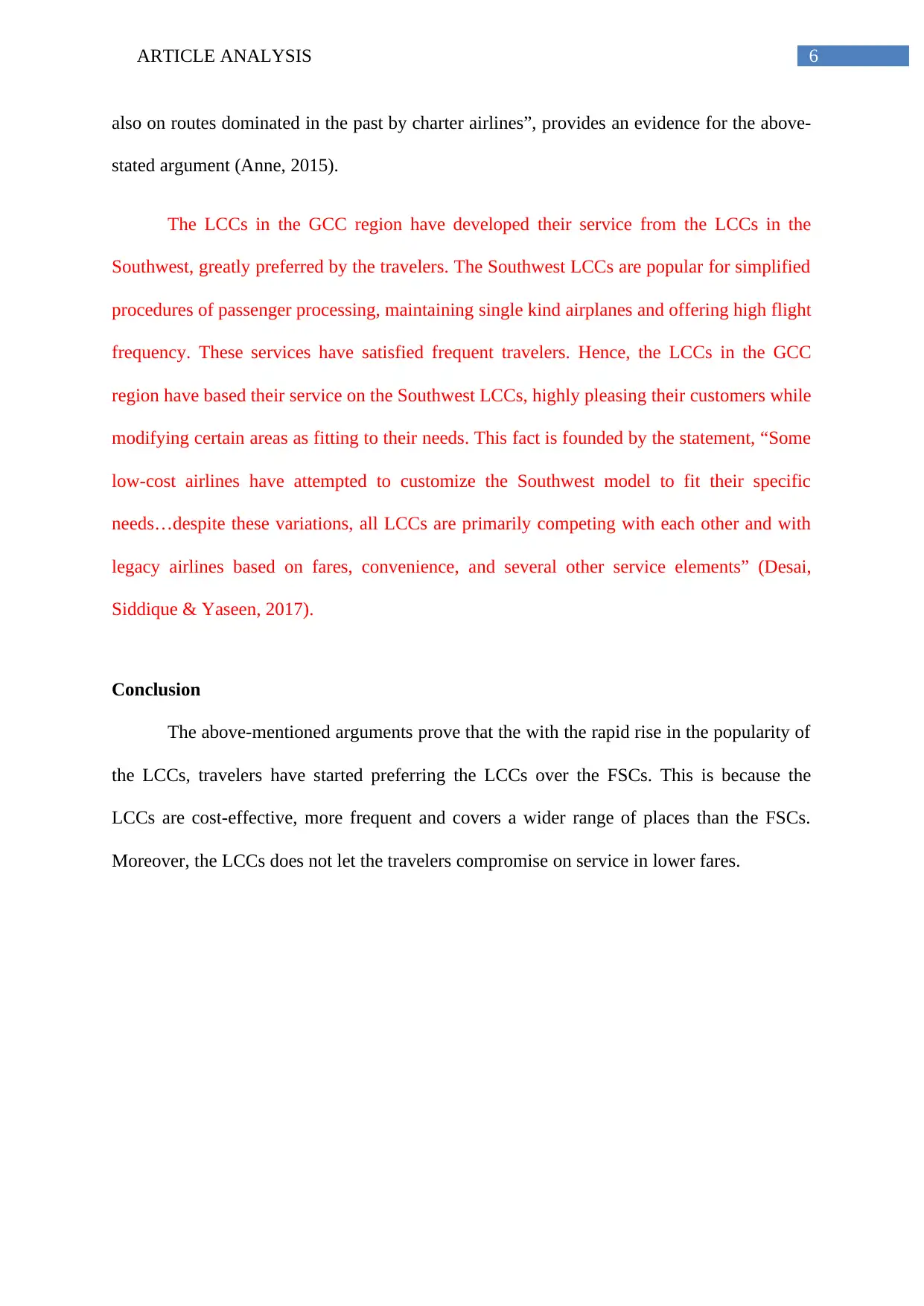
6ARTICLE ANALYSIS
also on routes dominated in the past by charter airlines”, provides an evidence for the above-
stated argument (Anne, 2015).
The LCCs in the GCC region have developed their service from the LCCs in the
Southwest, greatly preferred by the travelers. The Southwest LCCs are popular for simplified
procedures of passenger processing, maintaining single kind airplanes and offering high flight
frequency. These services have satisfied frequent travelers. Hence, the LCCs in the GCC
region have based their service on the Southwest LCCs, highly pleasing their customers while
modifying certain areas as fitting to their needs. This fact is founded by the statement, “Some
low-cost airlines have attempted to customize the Southwest model to fit their specific
needs…despite these variations, all LCCs are primarily competing with each other and with
legacy airlines based on fares, convenience, and several other service elements” (Desai,
Siddique & Yaseen, 2017).
Conclusion
The above-mentioned arguments prove that the with the rapid rise in the popularity of
the LCCs, travelers have started preferring the LCCs over the FSCs. This is because the
LCCs are cost-effective, more frequent and covers a wider range of places than the FSCs.
Moreover, the LCCs does not let the travelers compromise on service in lower fares.
also on routes dominated in the past by charter airlines”, provides an evidence for the above-
stated argument (Anne, 2015).
The LCCs in the GCC region have developed their service from the LCCs in the
Southwest, greatly preferred by the travelers. The Southwest LCCs are popular for simplified
procedures of passenger processing, maintaining single kind airplanes and offering high flight
frequency. These services have satisfied frequent travelers. Hence, the LCCs in the GCC
region have based their service on the Southwest LCCs, highly pleasing their customers while
modifying certain areas as fitting to their needs. This fact is founded by the statement, “Some
low-cost airlines have attempted to customize the Southwest model to fit their specific
needs…despite these variations, all LCCs are primarily competing with each other and with
legacy airlines based on fares, convenience, and several other service elements” (Desai,
Siddique & Yaseen, 2017).
Conclusion
The above-mentioned arguments prove that the with the rapid rise in the popularity of
the LCCs, travelers have started preferring the LCCs over the FSCs. This is because the
LCCs are cost-effective, more frequent and covers a wider range of places than the FSCs.
Moreover, the LCCs does not let the travelers compromise on service in lower fares.
Paraphrase This Document
Need a fresh take? Get an instant paraphrase of this document with our AI Paraphraser
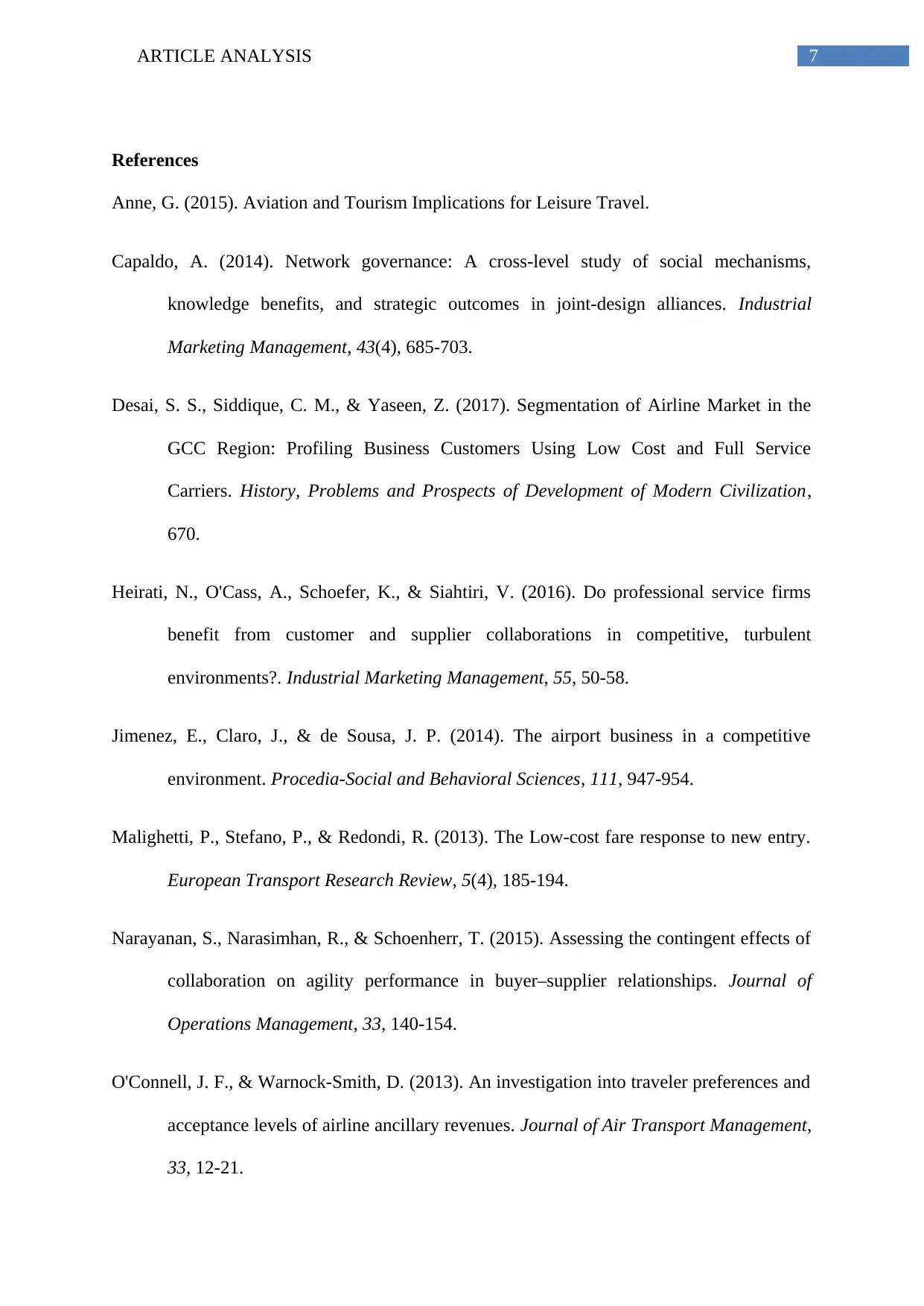
7ARTICLE ANALYSIS
References
Anne, G. (2015). Aviation and Tourism Implications for Leisure Travel.
Capaldo, A. (2014). Network governance: A cross-level study of social mechanisms,
knowledge benefits, and strategic outcomes in joint-design alliances. Industrial
Marketing Management, 43(4), 685-703.
Desai, S. S., Siddique, C. M., & Yaseen, Z. (2017). Segmentation of Airline Market in the
GCC Region: Profiling Business Customers Using Low Cost and Full Service
Carriers. History, Problems and Prospects of Development of Modern Civilization,
670.
Heirati, N., O'Cass, A., Schoefer, K., & Siahtiri, V. (2016). Do professional service firms
benefit from customer and supplier collaborations in competitive, turbulent
environments?. Industrial Marketing Management, 55, 50-58.
Jimenez, E., Claro, J., & de Sousa, J. P. (2014). The airport business in a competitive
environment. Procedia-Social and Behavioral Sciences, 111, 947-954.
Malighetti, P., Stefano, P., & Redondi, R. (2013). The Low-cost fare response to new entry.
European Transport Research Review, 5(4), 185-194.
Narayanan, S., Narasimhan, R., & Schoenherr, T. (2015). Assessing the contingent effects of
collaboration on agility performance in buyer–supplier relationships. Journal of
Operations Management, 33, 140-154.
O'Connell, J. F., & Warnock-Smith, D. (2013). An investigation into traveler preferences and
acceptance levels of airline ancillary revenues. Journal of Air Transport Management,
33, 12-21.
References
Anne, G. (2015). Aviation and Tourism Implications for Leisure Travel.
Capaldo, A. (2014). Network governance: A cross-level study of social mechanisms,
knowledge benefits, and strategic outcomes in joint-design alliances. Industrial
Marketing Management, 43(4), 685-703.
Desai, S. S., Siddique, C. M., & Yaseen, Z. (2017). Segmentation of Airline Market in the
GCC Region: Profiling Business Customers Using Low Cost and Full Service
Carriers. History, Problems and Prospects of Development of Modern Civilization,
670.
Heirati, N., O'Cass, A., Schoefer, K., & Siahtiri, V. (2016). Do professional service firms
benefit from customer and supplier collaborations in competitive, turbulent
environments?. Industrial Marketing Management, 55, 50-58.
Jimenez, E., Claro, J., & de Sousa, J. P. (2014). The airport business in a competitive
environment. Procedia-Social and Behavioral Sciences, 111, 947-954.
Malighetti, P., Stefano, P., & Redondi, R. (2013). The Low-cost fare response to new entry.
European Transport Research Review, 5(4), 185-194.
Narayanan, S., Narasimhan, R., & Schoenherr, T. (2015). Assessing the contingent effects of
collaboration on agility performance in buyer–supplier relationships. Journal of
Operations Management, 33, 140-154.
O'Connell, J. F., & Warnock-Smith, D. (2013). An investigation into traveler preferences and
acceptance levels of airline ancillary revenues. Journal of Air Transport Management,
33, 12-21.
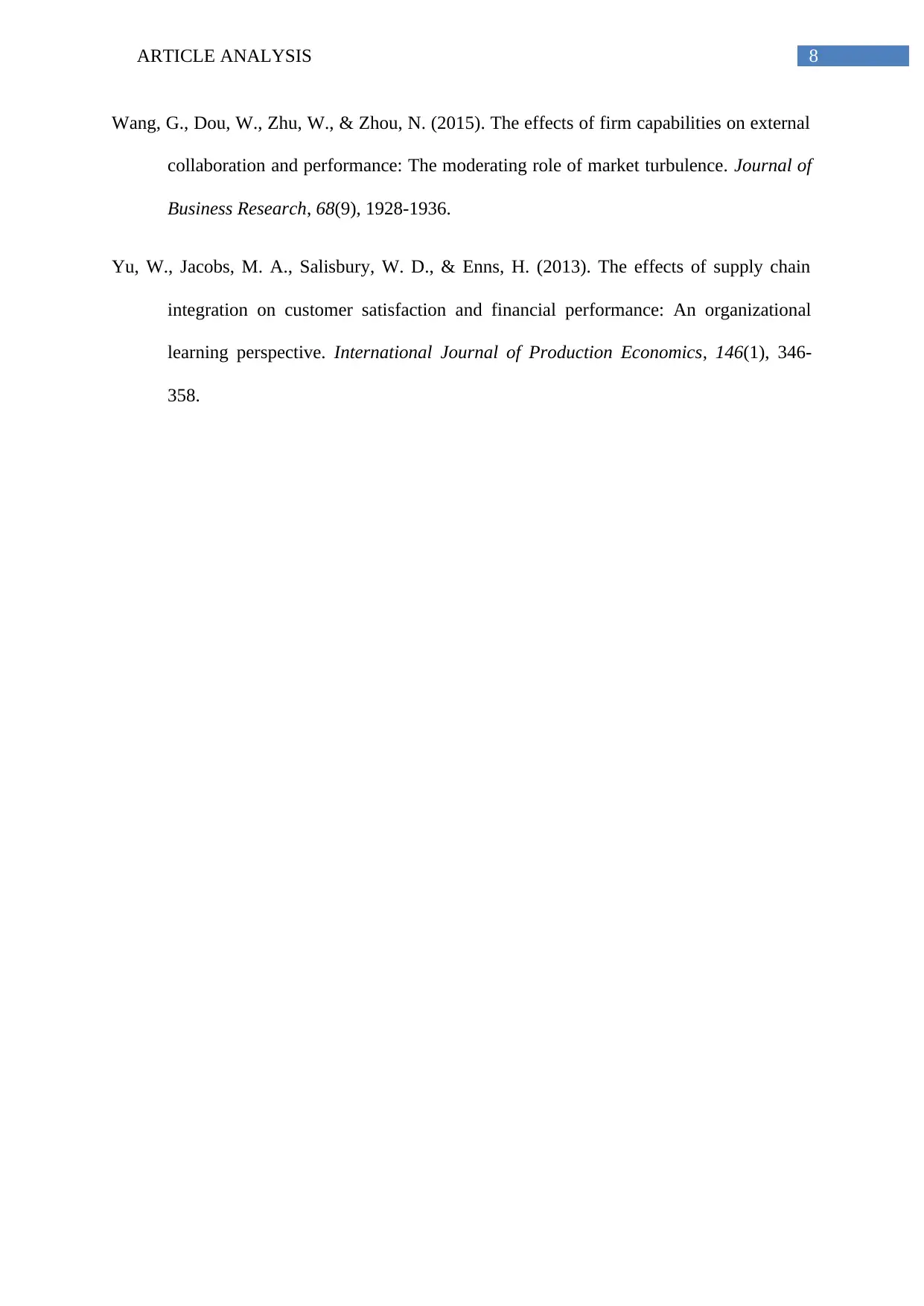
8ARTICLE ANALYSIS
Wang, G., Dou, W., Zhu, W., & Zhou, N. (2015). The effects of firm capabilities on external
collaboration and performance: The moderating role of market turbulence. Journal of
Business Research, 68(9), 1928-1936.
Yu, W., Jacobs, M. A., Salisbury, W. D., & Enns, H. (2013). The effects of supply chain
integration on customer satisfaction and financial performance: An organizational
learning perspective. International Journal of Production Economics, 146(1), 346-
358.
Wang, G., Dou, W., Zhu, W., & Zhou, N. (2015). The effects of firm capabilities on external
collaboration and performance: The moderating role of market turbulence. Journal of
Business Research, 68(9), 1928-1936.
Yu, W., Jacobs, M. A., Salisbury, W. D., & Enns, H. (2013). The effects of supply chain
integration on customer satisfaction and financial performance: An organizational
learning perspective. International Journal of Production Economics, 146(1), 346-
358.
⊘ This is a preview!⊘
Do you want full access?
Subscribe today to unlock all pages.

Trusted by 1+ million students worldwide
1 out of 9
Related Documents
Your All-in-One AI-Powered Toolkit for Academic Success.
+13062052269
info@desklib.com
Available 24*7 on WhatsApp / Email
![[object Object]](/_next/static/media/star-bottom.7253800d.svg)
Unlock your academic potential
Copyright © 2020–2025 A2Z Services. All Rights Reserved. Developed and managed by ZUCOL.





